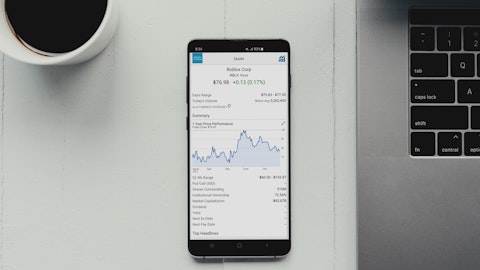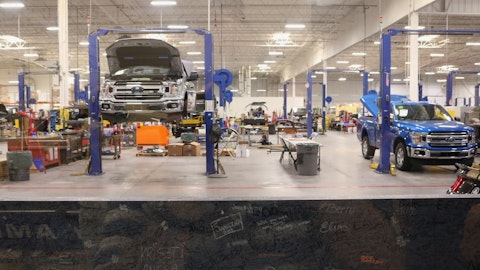Advance Auto Parts, Inc. (NYSE:AAP) Q4 2022 Earnings Call Transcript February 28, 2023
Operator: Hello and welcome to the Advance Auto Parts Fourth Quarter and Full Year 2022 Conference Call. Before we begin, Elisabeth Eisleben, Senior Vice President, Communications and Investor Relations, will make a brief statement concerning forward-looking statements that will be discussed on this call. You may now begin.
Elisabeth Eisleben: Good morning, and thank you for joining us to discuss our Q4 and full year 2022 results. I’m joined by Tom Greco, President and Chief Executive Officer; and Jeff Shepherd, Executive Vice President and Chief Financial Officer. Following their prepared remarks, we will turn our attention to answering your questions. Before we begin, please be advised that remarks today will contain forward-looking statements. All statements, other than statements of historical fact are forward-looking statements, including, but not limited to, statements regarding our initiatives, plans, projections and future performance. Actual results could differ materially from those projected or implied by the forward-looking statements.
Additional information about factors that could cause actual results to differ can be found under the caption Forward-Looking Statements and Risk Factors in our most recent annual report on Form 10-K and subsequent filings made with the commission. Now let me turn the call over to Tom Greco.
Tom Greco: Thanks, Elisabeth, and good morning, everyone. Before getting into the details of the fourth quarter and full year 2022 results, I’d like to begin by addressing our CEO succession news announced this morning. After months of deliberation, I’ve informed the Board that I plan to retire at the end of the year. I believe that now is the right time to begin transitioning leadership for Advance’s next chapter, not only for my family and me, but for the business for two important reasons. First, we’re in the final year of our 3-year strategic plan and are in the process of updating our next multi-year strategy. The timing will help enable my successor to play a role as we undertake this work to ensure the long-term success of Advance.
Second, the timing of this leadership transition will allow ample time for me to work with the Board’s succession committee to identify my successor. The committee will be conducting a thorough and comprehensive search that considers both internal and external candidates and facilitate a smooth transition. We are focused on finding a candidate, who can ensure that we continue to deliver for customers and drive long-term shareholder value. In the meantime, I’m committed to the execution of our ’23 plan to ensure Advance will continue our trajectory and capitalize on the significant opportunity ahead. With this in mind, we have a lot to cover on our call today, so let me provide the key themes you’ll hear from us. First, while we’re not happy with our overall results in 2022, the decisive actions we took in the latter half of the year, led to improved performance in Q4, and we expect that to continue into 2023.
Second, after several years of significant investments in complex transformation initiatives and with the majority of the integration behind us, we’re now able to focus more time and resources on improving execution. Third, we remain focused on our plan to drive long-term shareholder value behind our four TSR drivers. This includes leveraging our differentiated professional assets to accelerate sales and profitable growth in our largest sales channel. So let’s get started. Well, 2022 was a challenging year for AAP and our overall results did not meet expectations. The hard work and dedication of our team members helped us end the year on a more positive note. We delivered improved top line results in the fourth quarter as we expanded our footprint, increase customer loyalty and leverage the DieHard brand to gain DIY market share.
We continue to execute the disciplined inventory and pricing actions we discussed last quarter. These actions contributed to stronger results and we expect to improve parts availability throughout 2023, which we believe is the single most important driver to accelerate top line growth. We also finished the year with expanded adjusted operating margins and returned more than $930 million in cash back to our shareholders in the form of share buybacks and dividends. Looking at our Q4 performance. Net sales increased 3.2%, and comparable store sales increased 2.1%. Q4 was led by mid-single digit comp sales growth in DIY omnichannel. Our professional business was slightly positive for the quarter. As we continue to expand our footprint, our new locations are providing incremental revenue growth.
In 2022, we opened 144 new stores and branches, including most of our planned California locations. Looking at our sales performance in Q4 from a category perspective. Growth was led by continued strength in batteries behind DieHard with a double-digit increase compared to Q4 last year. We also saw strength in Fluids and Motor Oil. Regionally, the West, Florida and mid-Atlantic outperformed our other regions. It’s important to note we gained DIY omnichannel share in the quarter based on syndicated data. In Q4, we expanded adjusted operating income margin 146 basis points. Adjusted diluted earnings per share increased by 39.1%, primarily driven by the increase in operating income margin and inclusive of a benefit from the functional currency change of one of our subsidiaries outlined in our press release.
For the full year, net and comp sales results increased 1.4% and 0.3%, respectively. Turning to margins and profitability. Adjusted operating income margin expanded 24 basis points and adjusted diluted earnings per share grew 8.5%. As we discussed throughout 2022, one of the most significant SG&A headwinds we faced was related to our California expansion. Our start-up costs for these new stores were significantly above our initial expectations for the year, which Jeff will discuss further. As you know, we’ve gone through a complex transformation spending several years of significant investment, with the majority of this effort behind us, we’re now able to focus more resources on driving execution and operating performance, including the opportunities discussed last quarter.
First, we made targeted investments to get more SKUs closer to the customer. It’s important to note that in-stock rates for front room categories were strong in the quarter, as evidenced by sales growth and DIY share gains within DieHard batteries and Motor Oil. Inventory investments were concentrated in backroom hard parts categories. As expected, we saw modest improvements in our in-stock levels and performance in Q4 across these categories. We’re continuing to work in close collaboration with supplier partners to ensure our in-stock levels within these categories continue to build in Q1 and throughout the balance of the year. Second, we continue to execute our category management strategy, an important driver of gross margin expansion for us.
This strategy focuses on own brand penetration, strategic pricing and strategic sourcing. In terms of own brand penetration, we ended the year at 50.5% of mix, which increased 210 basis points compared with the prior year behind the strength of DieHard and Carquest. Owned brands continue to be an important differentiator for us and provide a mix of good, better and best options. Last quarter, we also talked about plans to leverage new capabilities to make surgical price investments. Through detailed reviews of our performance, we’ve made targeted investments and we’ll closely monitor and adjust pricing as needed given industry dynamics. Beyond these initiatives, I want to mention a couple of other action items, we believe will add value and help drive growth in 2023.
First, we remain focused on building our brands to drive distinction and pricing power. We recently launched our DieHards Choose DieHard, a 60 second documentary-style video campaign featuring Kirstie Ennis, a former marine Sergeant and world-renowned climber, who is the embodiment of DieHard attributes of reliability, durability and power. Titled, The Climber, this campaign is appearing on Advance’s social media pages and debuted in theaters. We’re confident this campaign will continue to help build awareness of both DieHard and Advance. Second, we continue to expand our customer loyalty program, Speed Perks to increase share of wallet with DIYers. In 2022, we increased membership by nearly 1 million members and our percent of transactions grew by 100 basis points year-over-year.
We finished 2022 with 13.6 million active members, contributing to our strong DIY performance in the quarter and view this as a continued growth driver for our company in 2023. Third, we continue to invest in digital capabilities in both DIY and Pro. On our B2C website, we improved shopability to drive higher conversion and growth. We also continue to invest in our mobile app, including homepage design with a better user dashboard for Speed Perks members and optimize placement for featured products and promotions. Within Professional, we integrated the Advance Pro platform into new shop management and procurement systems. This drives efficiency and ease of doing business by providing more professional customers with delivery estimates. In addition, we improved our B2B online experience, which resulted in a significant increase in digital penetration.
Now let me speak to our longer-term strategy to grow our professional business, where we start from a position of strength. As we said previously, we’re the only major company with a pure play professional model behind Worldpac. Now that Autopart International has been fully-integrated into Worldpac, we have 316 existing locations that are dedicated to serving the professional customer with significantly more hard part SKUs than a traditional retail store. We also have nearly 330 Advance hubs and super hubs, which offer a broad range of parts. These assets allow us to better serve the needs of our professional customers with a comprehensive line-up of national brands, owned brands and OE parts focused on what the Pro customers need. We’re now well-positioned to execute the next generation of our strategy to profitably grow our professional business by getting the right part in the right place at the right time.
Ultimately, this will involve positioning our enterprise-wide assortment as close to the customer as possible, ideally under one roof to provide consistent and reliable delivery of the entire job. As an example, in Toronto, we recently combined two distribution centers into one with our enterprise assortment located in a single building. We’re pleased with the early results we are seeing in Toronto and believe a similar approach to this has the potential to provide a superior customer experience in other markets across North America. For years, Worldpac has leveraged online ordering from its customers to determine assortment and to ensure we have the right part, utilized a singular demand signal to position inventory in the right place and provided a clear window for delivery, so the installer consistently gets the part at the right time.
Five years ago, we had four disparate supply chain and technology platforms. However, today, our systems are much better connected and enable us to take learnings from Worldpac and apply them across all of our Pro business. Our vision here is to leverage the entirety of our enterprise assets to provide a superior customer experience within Pro as we accelerate growth and profitability. We look forward to sharing more on the next evolution of our strategy. Before I turn the call over to Jeff, let me speak briefly about how we’re thinking about 2023. As the final integration and amortization costs wind down, we’ve made the decision to shift to GAAP results as our guidance metric. Jeff will provide further rationale for this. But we’re excited to see our broader integration costs coming to an end culminating in the exhaustion of GPI amortization costs in 2025.
As we begin the year, we remain cautious surrounding the macroeconomic backdrop, including the potential for ongoing pressure on low to middle income consumers. However, our 2023 guidance is underpinned by continued industry strength with the drivers of demand remaining positive. Further, we expect the strategic inventory investments we began in the second half of 2022 will help drive growth in 2023. In terms of our expectations for the year, we’re guiding to growth in net and comp sales, as well as GAAP operating income margin expansion. I’ll now turn the call over to Jeff to review our Q4 and full year financials in more detail and provide our outlook for 2023. Jeff?

Copyright: wihtgod / 123RF Stock Photo
Jeff Shepherd: Thanks, Tom, and good morning. I would also like to start by thanking our team members for their commitment to Advance this past year. While the year was not without challenges, our team members continue to put our customers first. In Q4, net sales of $2.5 billion increased 3.2% compared with Q4 2021, driven by strategic pricing and new store openings. Comparable store sales increased 2.1%. Adjusted gross profit margin expanded slightly to 46.9% compared with 46.8%. This was driven by strategic pricing, channel mix favorability and own brand expansion. In the quarter, same-SKU cost inflation was approximately 6.9%. Q4 adjusted SG&A of $943 million was flat compared with the prior year. As a percent of net sales, adjusted SG&A improved 136 basis points.
This was primarily driven by a year-over-year decrease in incentive compensation and marketing expenses. In terms of marketing, we improved efficiencies in the quarter by shifting to higher return investments within the marketing mix. We also incurred lower start-up costs versus the prior year as a result of the ramp-up of our new store openings in California. These benefits were partially offset by inflation in store labor and higher medical costs. Our Q4 adjusted operating income was $219 million, an increase of 23.6%. Our Q4 adjusted OI margin rate was 8.8%, an increase of 146 basis points, and our adjusted diluted earnings per share increased 39.1% to $2.88. The EPS improvement was driven by stronger operational results and a Q4 benefit of approximately $0.16, due to a change in the functional currency of our subsidiary in Taiwan.
For the full year 2022, net sales of $11.2 billion increased 1.4%, compared with the prior year. Our adjusted gross profit increased 4.4% and adjusted gross profit margin expanded 135 basis points to 47.3%. Adjusted SG&A expenses for the full year 2022 increased 4.5%, compared with 2021. On a rate basis, adjusted SG&A as a percent of net sales increased 111 basis points to 37.5%. As we discussed throughout 2022, our expansion in California weighed on SG&A throughout the year. Delays in permitting and construction, resulted in significantly fewer sales weeks than we planned for our California-based stores. As you’ll recall, we made a decision early on to hire the existing Pep Boys team members in the stores prior to opening, given the tight labor market.
This helped ensure, we have the customer relationships and geographic knowledge needed for long-term success. In short, we are paying rent and store payroll without sales well in excess of our original plan. We called out these costs each quarter last year, but for perspective, it represented approximately $60 million in start-up costs in 2022. The good news is we now have nearly 90 stores open, and the start-up costs are largely behind us with less than 20 stores left to open. The stores are gaining more, share in DIY every period, and we’re building the professional business week-by-week. We’re now able to service our large and vitally important national Pro customers in California, which will continue to build over time. Our full year 2022 adjusted operating income increased 4% to $1.1 billion.
On a rate basis, our adjusted OI margin expanded 24 basis points to 9.8%. Our adjusted diluted earnings per share of $13.04 increased 8.5%. Our 2022 capital expenditures were $424 million compared with $290 million the previous year. This was driven by our continued investment in the business, primarily related to our new store openings, IT and supply chain. As we continue to execute on our strategic objectives for 2023, our overall capital allocation priorities remain unchanged, and we plan to continue to deliver for customers and shareholders alike. Free cash flow for the full year was $298 million. As Tom mentioned, we’re making strategic inventory investments to improve availability in 2023, which are important to accelerate growth this year.
In addition, through process and technology improvements, we were able to process disputed payables more efficiently. In 2022, we returned approximately $934 million through a combination of share repurchases and our quarterly cash dividend. Our Board also recently approved our quarterly cash dividend of $1.50. Turning to 2023 guidance. As Tom mentioned, we’re shifting to GAAP measures for the purposes of guidance and will no longer be reporting non-GAAP results beginning in 2023. There are three primary drivers pertaining to the timing of this decision. First, our transformation costs are getting less impactful, reducing the need for non-GAAP adjustments. Our largest integration initiatives are largely completed, and our amortization cost will be exhausted in 2025.
Second, no longer reporting on a non-GAAP basis will improve comparability with our peers, including similar treatment of LIFO moving forward. And lastly, many investors and analysts have requested that we prioritize GAAP metrics. Ultimately, our intention with this change is to help enhance the transparency and simplify our financial reporting going forward consistent with feedback we received. With that said, this year, we will continue to highlight activities and related costs that were previously excluded from GAAP results, including, but not limited to, impact associated with LIFO, our transformation-related costs and amortization associated with the GPI acquisition. Our 2023 guidance is highlighted by modest growth in both our net and comp sales and GAAP margin expansion.
Our 2023 guide is underpinned by a cautious macroeconomic outlook given the pressure on low and middle income consumers. Balanced with the continued industry strength as the primary driver’s demand remain positive. In 2023, we expect product cost inflation of mid-single digits overall, with moderation throughout the year. From a phasing standpoint, we expect Q1 2023 to be the most challenging quarter of the year for three reasons. First, based on GAAP accounting, we expect higher product costs year-over-year in Q1 than in subsequent quarters. Second, we expect to build sales momentum throughout the year as we improve availability. Third, we expect higher transformation costs within SG&A in Q1. Given these factors, we expect to experience stronger growth and margin expansion post Q1.
Considering these factors, our guidance includes net sales of $11.4 billion to $11.6 billion. Comparable store sales of 1% to 3%, GAAP operating income margin of 7.8% to 8.2%, income tax rate of 24% to 25%, diluted earnings per share of $10.20 to $11.20, capital expenditures of $300 million to $350 million, a minimum of $400 million in free cash flow and 60 to 80 new store and branch openings. With last year’s investment in inventory resulting in higher payable payments this year and anticipated continued inventory investments, we’ve temporarily paused share repurchases under our existing program. And at this time, we’re not guiding a range of repurchases for the full year. Importantly, we remain committed to paying quarterly cash dividends.
Over the long term, we remain committed to a balanced capital allocation approach and returning excess cash to shareholders. With that, I’d like to turn it back over to Tom for closing remarks.
Tom Greco: Thanks, Jeff. Since I joined this team in 2016, I’ve seen this company make terrific progress. I believe we have a strong team in place and a sturdy foundation for growth and profitability both in 2023 and beyond. With the heavy lifting of the integration behind us, I’m confident we’re better positioned now for growth and value creation than ever before. With that, let’s open the phone lines to questions. Operator?
See also 15 Countries that Make the Best Beer in the World and 20 Largest FMCG Companies in the World .
Q&A Session
Follow Advance Auto Parts Inc (NYSE:AAP)
Follow Advance Auto Parts Inc (NYSE:AAP)
Q – Simeon Gutman: Hey. Good morning, everyone. Tom, wishing you well. I’m sorry, I forget the timing, if its too soon, then I wish you well again. My question is on the margin. The GAAP EBIT margin around 8-ish percent, give or take, is not that different from where this business was several years ago. So the question is, is there some gap of inefficiency relative to peers? Or should we think about margin expansion from here is more ratable with sales growth going forward?
Tom Greco: Good morning, Simeon. We still see a substantial opportunity to grow margins and drive EPS and therefore shareholder value. The fact that we’ve moved to GAAP doesn’t change that. We’re going to be working through our strategic plan in ’24 through ’26. One of the things that we’re excited about is have the integration behind us. And that means the transformation costs that we’ve been calling out are going to be coming down over time. You’ve heard in the prepared remarks that the amortization is exhausted completely by 2025. The integration costs will come down. So that will help us with margin expansion. We talked about changes in the competitive landscape last fall that impacted the Pro sales channel, but we’re confident that we can continue to grow margins from here. Right now, we’re obviously focused on 2023 and delivering our guidance for the year.
Simeon Gutman: And then a follow-up on the free cash flow. Is this year’s number encumbered by inventory purchases and then that doesn’t repeat? Or is this a reasonable framework, I guess, both CapEx as well as working capital. And then that grows ratably with the earnings power of the business.
Jeff Shepherd: Yes, really, it’s the – it’s what you said in the beginning there in terms of our investment in inventory in 2022 and in the early part of 2023, we’re just responding to that change in competitive landscape with regards to inventory investment. So we’re going to be investing in our inventory to compete more effectively and really better serve our customers. This is primarily within professional. So we expect this to be a 2023 investment, and we would see changes going forward. And we’re working through that right now as we work on our SPP for ’24 through ’26.
Simeon Gutman: Okay. Thanks, Jeff. Thanks, Tom, and good luck.
Operator: Thank you. Our next question comes from Chris Horvers of JPMorgan Chase. Chris, your line is now open. Please go ahead.
Christian Carlino: Hi. It’s Christian Carlino on for Chris. On the fourth quarter, could you just give us some sense of how much you think weather benefited the quarter? And any color on quarter-to-date performance?
Tom Greco: Hey, good morning. We had a really strong quarter in DIY. We talked — called out the mid-single digit growth there. We did gain share in DIY in the quarter. December was obviously colder than it was the previous year in the northern market. So we did benefit from that. So overall, weather was a slight benefit to us, I would say, in the fourth quarter. That said, we gained share. So we feel good about our relative performance in DIY, which is the one that tends to move more with weather. But we’re not going to comment on specific quarter-to-date results. December was colder. January was warmer and you all know that, but we’ve fully contemplated that in our full year guide. And we said that we expect our comp sales to improve this year as the year goes on. That’s an important point. The inventory availability investments that we’ve been making are going to benefit us more as the year goes on.
Christian Carlino: Got it. And then on the margin guidance, could you help us understand the complexion of gross margin versus SG&A outlook? And more specifically, do you still expect the capitalized cost headwinds to primarily hit in the first half? Or should continue inflation should continued inflation drag that out into the second half potentially?





